
The Aizoaceae, or fig-marigold family, is a large family of dicotyledonous flowering plants containing 135 genera and about 1800 species. They are commonly known as ice plants or carpet weeds. They are often called vygies in South Africa and New Zealand. Highly succulent species that resemble stones are sometimes called mesembs.

Lithops is a genus of succulent plants in the ice plant family, Aizoaceae. Members of the genus are native to southern Africa. The name is derived from the Ancient Greek words λίθος 'stone' and ὄψ 'face', referring to the stone-like appearance of the plants. They avoid being eaten by blending in with surrounding rocks and are often known as pebble plants or living stones. Lithops is both the genus name and the common name. The formation of the name from the Ancient Greek -ops means that even a single plant is called a Lithops.

Glottiphyllum longum is a species of succulent plant in the family Aizoaceae, native to the Western Cape and Eastern Cape Provinces, South Africa.
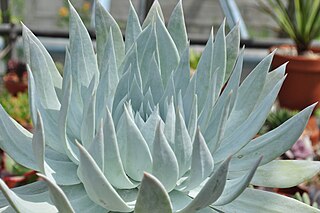
Dudleya brittonii, with the common names Britton's dudleya, Britton's liveforever and giant chalk dudleya, is a succulent plant in the family Crassulaceae. It is native to the coast of northern Baja California, Mexico. Both forms of the plant have yellow leaves on a clustered rosette atop a large reddish-purple peduncle. The white form of the plant has a chalky epicuticular wax that reflects light and reacts with water. The green form of the plant is more common and found throughout a wider range. It is among the largest of the Dudleya.

Haworthia truncata, locally known as horse's teeth, is a species of succulent plant in the genus Haworthia. It is found in the Little Karoo region, in the far east of the Western Cape Province, South Africa.

Lithops francisci, commonly known as one of the living stones or pebble plants, is in the family Aizoaceae. It is endemic to the arid desert environments of Namibia. It is a succulent with a natural habitat in rocky areas. L. francisci was assessed by Nicholas Edward Brown in 1925. It is one of the Lithops plants and shares the characteristic bi-leaf head pattern separated by a deep fissure, the bottom of which houses and protects the stunted stem.
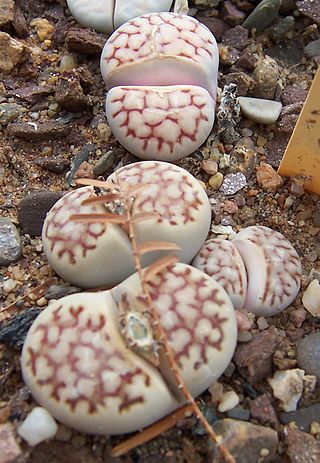
Lithops karasmontana, is a species of flowering plant in the ice plant family Aizoaceae, native to Namibia and South Africa.
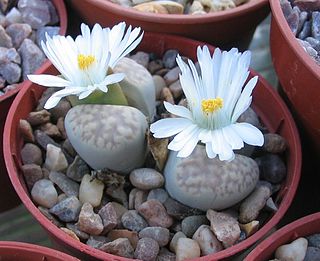
Lithops amicorum is a small succulent plant with white flowers, one of the smallest in the genus. It was named for the group of four friends who discovered it. It was collected by Desmond T. and Naureen A. Cole on 3 May 2004. After recent molecular analysis it was recombined to be a subspecies of Lithops karasmontana rather than its own species.

Leaf window, also known as epidermal window, and fenestration, is a specialized leaf structure consisting of a translucent area through which light can enter the interior surfaces of the leaf where photosynthesis can occur. The translucent structure may include epidermal tissue, and in some succulent plants it consists of several cell layers of parenchyma, which may also function as water-storage tissue. It can appear as a large continuous patch, a variegated or reticulated region, or as numerous small spots. It is found in some succulent plants native to arid climates, allowing much of the plant to remain beneath the soil surface where it is protected from desiccation by winds and heat while optimizing light absorption. Many species featuring leaf windows are native to Southern Africa.
Vlokia ater was the first species described for the genus Vlokia in the Aizoaceae plant family. The genus name honors the discoverer, South African botanist, Jan H. J. Vlok (1957-). The species name derives from the Latin adjective "ater" for "black" and refers to the black coloring which older leaf leaves assume.
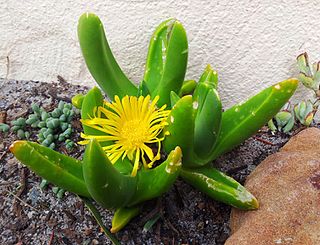
Glottiphyllum regium is a rare species of succulent plant, in the family Aizoaceae. It is known locally as "koeispene". It is restricted to a small arid area near Calitzdorp in the Western Cape, South Africa.

Glottiphyllum depressum is a common species of succulent plant, of the family Aizoaceae, native to South Africa.
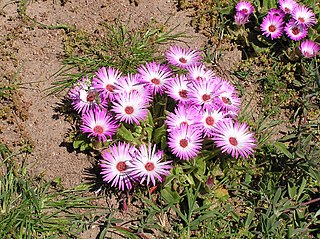
Dorotheantheae is a small tribe of annual succulents in the Aizoaceae subfamily Ruschioideae. Though it originally comprised three genera, Cleretum remains as the only recognised genus. Dorotheantheae are endemic to the western and south-western parts of South Africa. The type genus is Dorotheanthus, despite it being no longer recognised.
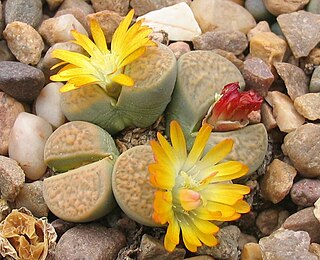
Lithops divergens is a succulent plant species in the genus Lithops of the family Aizoaceae. It is endemic to the western Cape Provinces of South Africa. It is able to withstand intense climatic changes due to its resilience as a succulent. The average annual rainfall for its natural environment is less than 150 mm, occurring primarily in winter which is unusual for a Lithops.

Lithops otzeniana is a species of succulent plant under the genus Lithops. It belongs to the family Aizoaceae. L. otzeniana is native to to the Northern Cape province of South Africa. It derives its name from M. Otzen, who invited its discoverer, G.C. Nel, on the trip in which he discovered it.
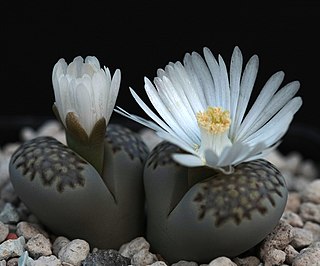
Lithops julii is a species of succulent plant of the genus Lithops under the family Aizoaceae. It is native to Southern Africa, and was first collected by Kurt Dinter, a German botanist, and named after his friend, Julius Derenberg.
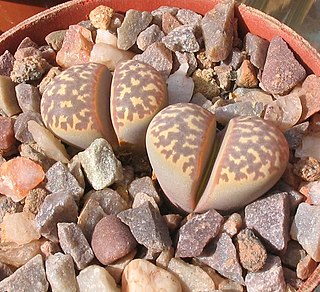
Lithops naureeniae is a species of pebble plant (Lithops), in the family Aizoaceae. It is native to the Northern Cape province of South Africa. The succulent is adapted to the desert climate in which it lives. L. naureeniae was identified in 1980 by Desmond Cole, who became involved in Lithops research in 1947, from a specimen provided to him by Bruce Bayer, curator of the Karoo Botanic Garden, having been collected by Peter V. Bruyns in Namaqualand. It is named after Cole's wife, Naureen Cole. Cole wrote:
I therefore have pleasure in dedicating it to the person who, during the last fifteen years, directly and indirectly, has contributed more to research on and knowledge of the genus Lithops than any other—my wife, Naureen

Trichodiadema mirabile is succulent plant of the genus Trichodiadema, native to the Western Cape Province, South Africa, where it is known from the Laingsburg area and especially from south-facing slopes.
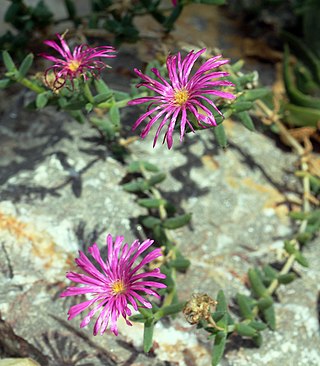
Trichodiadema barbatum is succulent plant of the genus Trichodiadema, native to the Eastern Cape Province, South Africa.
Acrodon deminutus, also known as the Malgas tiptoothfig, is a species of mesemb from South Africa.


















